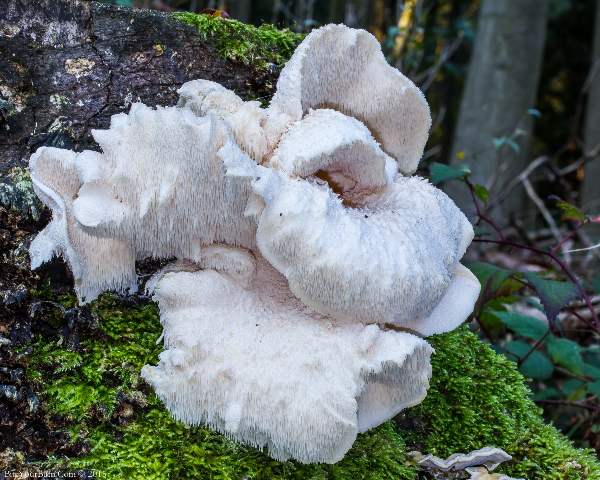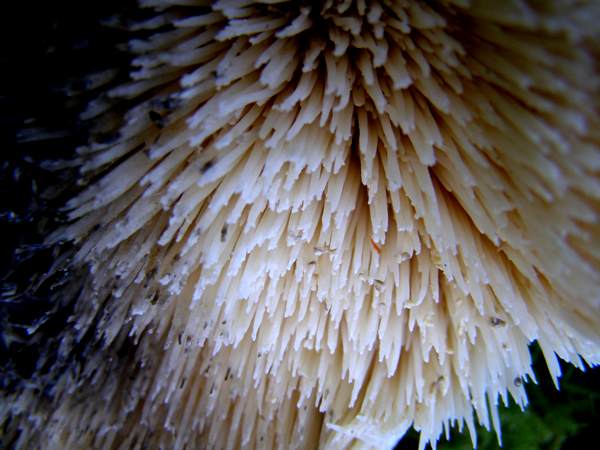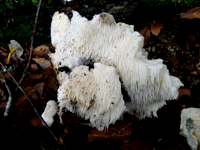Hericium cirrhatum (Pers.) Nikol. - Tiered Tooth
Phylum: Basidiomycota - Class: Agaricomycetes - Order: Russulales - Family: Hericiaceae
Distribution - Taxonomic History - Etymology - Identification - Culinary Notes - Reference Sources

This very rare tiered tooth fungus of dead hardwood trees in old (mainly deciduous) woodland has been reported from several sites in southern England, notably the New Forest.
Our (rather ageing and rain-drenched) specimen, pictured above, was found at Longleat, in Wiltshire. The spines are 10 to 15mm long - considerably shorter than those of the similar and closely related Bearded Tooth or Lion's Mane fungus, Hericium erinaceus.

Distribution
A very rare sight in Britain, where it is found mainly in southern England, Hericium cirrhatum occurs also in some parts of central and southern mainland Europe, but nowhere is it common.
Taxonomic history
When in 1801 Christiaan Hendrik Persoon described this wood-rotting fungus he gave it the binomial scientific name Hydnum cirrhatum. It was Russian mycologist Taisiya Lvovna Nikolayeva (1902 - 1982) who, in 1950, transferred this species to its current genus, thus establishing the scientific name Hericium cirrhatum by which it is generally known today.
Synonyms of Hericium cirrhatum include Hydnum cirrhatum Pers., Hydnum diversidens Fr., Creolophus cirrhatus (Pers.) P. Karst., and
Hericium diversidens (Fr.) Nikol.
Classification note: Although DNA analysis has confirmed that many tooth fungi (such as the Wood Hedgehog Hydnum repandum) are properly - Classified in the order Canthellales, the Tiered Tooth is now included in the order Russulales.
Etymology
Hericium, the generic name, means pertaining to a hedgehog, and is a reference to the spiny fertile surfaces of fungi within this grouping. The specific epithet cirrhatum means 'having tendrils' - another reference to the dangly spines.
Identification guide
 |
FruitbodyThis remarkable fungus and other member of the Hericiaceae are distinguished by their icicle-like spines. Hericium cirrhatum produces irregular cream fruitbodies with little or no real stem.The whole fruitbody is usually 5 to 10cm across, often occurring in tiered groups covering a large area. The typical thickness is 2 or 3cm. Spines are pointed and usually little more than 1 to 1.5cm long. |
SporesSubglobose, smooth, 3.5-4.5 x 3-3.5µm; amyloid. Spore printWhite. |
|
Odour/taste |
Odour not distinctive when young, although decaying specimens give off a nauseating smell. |
Habitat & Ecological role |
Saprobic, on dead wood of beech and occasionally other broadleaf trees, rarely appearing in the same place for more than a year or two. |
Season |
July to November in Britain. |
Similar species |
Hydnum rufescens and Hydnum repandum also have downward-projecting spines, but they are attached to a smooth-topped cap. Hericium erinaceus is also very rare in the UK; it has longer spines and a more spherical fruitbody. |
Culinary Notes
When young and fresh Hericium fungi are generally considered to be choice edibles with a fine flavour and texture similar to fish or tender meat. In Britain it is illegal to gather this very rare species, which has legal protection under Schedule 8 of the Wildlife and Countryside Act 1981 which precludes picking and destruction of the fruitbodies.
Reference Sources
Fascinated by Fungi, 2nd Edition, Pat O'Reilly 2016, reprinted by Coch-y-bonddu Books in 2022.
Dictionary of the Fungi; Paul M. Kirk, Paul F. Cannon, David W. Minter and J. A. Stalpers; CABI, 2008
Taxonomic history and synonym information on these pages is drawn from many sources but in particular from the British Mycological Society's GB Checklist of Fungi.
Acknowledgements
This page includes pictures kindly contributed by James Langiewicz.
Fascinated by Fungi. Back by popular demand, Pat O'Reilly's best-selling 450-page hardback book is available now. The latest second edition was republished with a sparkling new cover design in September 2022 by Coch-y-Bonddu Books. Full details and copies are available from the publisher's online bookshop...

